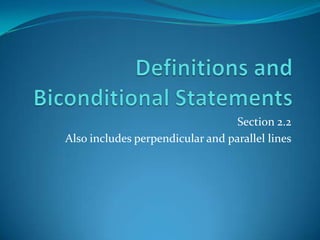Geo 2.2
- 1. Section 2.2 Also includes perpendicular and parallel lines
- 2. Perpendicular and Parallel ï Perpendicular lines intersect to form a right angle ï A line that is perpendicular to a plane is perpendicular to every line in that plane that it intersects ï Definitions, such as these, are meant to be interpreted in both directions. ï For example, the first definition could be written âTwo lines that form right angles are perpendicularâ
- 3. Biconditional Statements ï Like definitions, biconditional statements can be interpreted in both directions ï They are written in the form: <1st statement> if and only if <2nd statement> ï âIf and only ifâ is often abbreviated âiffâ ï One can make a biconditional statement if the conditional statement and its converse are both true (or both false, but why would you do that)
- 4. Reference ï McDougal Littel: Geometry, Section 2.2




